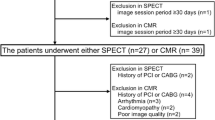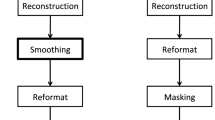Abstract
To assess the diagnostic accuracy of 16-detector-row computed tomography (16DCT) of the heart in the assessment of myocardial perfusion and viability in comparison to stress perfusion magnetic resonance imaging (SP-MRI) and delayed-enhancement magnetic resonance imaging (DE-MRI). A number of 30 patients underwent both 16DCT and MRI of the heart. Contrast-enhanced 16DCT data sets were reviewed for areas of myocardium with reduced attenuation. Both CT and MRI data were examined by independent reviewers for the presence of myocardial perfusion defects or myocardial infarctions (MI). Volumetric analysis of the hypoperfusion areas in CT and the infarct sizes in DE-MRI were performed. According to MRI, myocardial infarctions were detected in 11 of 30 cases, and perfusion defects not corresponding to an MI were detected in six of 30 patients. CTA was able to detect ten of 11 MI correctly (sensitivity 91%, specificity 79%, accuracy 83%), and detected three of six hypoperfusions correctly (sensitivity 50%, specificity 92%, accuracy 79%). Assessing the volume of perfusion defects correlating to history of MI on the CT images, a systematic underestimation of the true infarct size as compared to the results of DE-MRI was found (P<0.01). Routine, contrast-enhanced 16-detector row CT of the heart can detect chronic myocardial infarctions in the majority of cases, but ischemic perfusion defects are not reliably detected under resting conditions.




Similar content being viewed by others
References
Sabharwal NK, Lahiri A (2003) Role of myocardial perfusion imaging for risk stratification in suspected or known coronary artery disease. Heart 89(11):1291–1297
Kannel WB, Abbott RD (1984) Incidence and prognosis of unrecognized myocardial infarction. An update on the Framingham study. N Engl J Med 311(18):1144–1147
Constantine G, Shan K, Flamm SD, Sivananthan MU (2004) Role of MRI in clinical cardiology. Lancet 363(9427):2162–2171
Kim RJ, Fieno DS, Parrish TB, Harris K, Chen EL, Simonetti O et al. (1999) Relationship of MRI delayed contrast enhancement to irreversible injury, infarct age, and contractile function. Circulation 100(19):1992–2002
Paetsch I, Jahnke C, Wahl A, Gebker R, Neuss M, Fleck E et al. (2004) Comparison of dobutamine stress magnetic resonance, adenosine stress magnetic resonance, and adenosine stress magnetic resonance perfusion. Circulation 110(7):835–842
Barkhausen J, Hunold P, Jochims M, Debatin JF (2004) Imaging of myocardial perfusion with magnetic resonance. J Magn Reson Imaging 19(6):750–757
Nikolaou K, Poon M, Sirol M, Becker CR, Fayad ZA (2003) Complementary results of computed tomography and magnetic resonance imaging of the heart and coronary arteries: a review and future outlook. Cardiol Clin 21(4):639–655
Nikolaou K, Knez A, Sagmeister S, Wintersperger BJ, Reiser MF, Becker CR (2004) Assessment of myocardial infarctions using multirow-detector computed tomography. J Comput Assist Tomogr 28(2):286–292
Kellman P, Arai AE, McVeigh ER, Aletras AH (2002) Phase-sensitive inversion recovery for detecting myocardial infarction using gadolinium-delayed hyperenhancement. Magn Reson Med 47(2):372–383
Huber DJ, Lapray JF, Hessel SJ (1981) In vivo evaluation of experimental myocardial infarcts by ungated computed tomography. Am J Roentgenol 136(3):469–473
Slutsky RA, Peck WW, Mancini GB, Mattrey RF, Higgins CB (1984) Myocardial infarct size determined by computed transmission tomography in canine infarcts of various ages and in the presence of coronary reperfusion. J Am Coll Cardiol 3(1):138–142
Schmermund A, Gerber T, Behrenbeck T, Reed JE, Sheedy PF, Christian TF et al. (1998) Measurement of myocardial infarct size by electron beam computed tomography: a comparison with 99 mTc sestamibi. Invest Radiol 33(6):313–321
Georgiou D, Bleiweis M, Brundage BH (1992) Conventional and ultrafast computed tomography in the detection of viable versus infarcted myocardium. Am J Card Imaging 6(3):228–236
Ohnesorge B, Flohr T, Becker C, Kopp AF, Schoepf UJ, Baum U et al. (2000) Cardiac imaging by means of electrocardiographically gated multisection spiral CT: initial experience. Radiology 217(2):564–571
Kopp AF, Kuettner A et al. (2003) MDCT: cardiology indications. Eur Radiol 13(Suppl 5):M102–M115
Becker CR, Knez A, Leber A, Treede H, Ohnesorge B, Schoepf UJ et al. (2002) Detection of coronary artery stenoses with multislice helical CT angiography. J Comput Assist Tomogr 26(5):750–755
Nieman K, Cademartiri F, Lemos P, Raaijmakers R, Pattynama P, de Feyter P (2002) Reliable noninvasive coronary aniography with fast submillimeter multislice spiral computed tomography. Circulation 106:2051–2054
Achenbach S, Giesler T, Ropers D, Ulzheimer S, Derlien H, Schulte C et al. (2001) Detection of coronary artery stenoses by contrast-enhanced, retrospectively electrocardiographically-gated, multislice spiral computed tomography. Circulation 103(21):2535–2538
Mahrholdt H, Wagner A, Parker M, Regenfus M, Fieno DS, Bonow RO et al. (2003) Relationship of contractile function to transmural extent of infarction in patients with chronic coronary artery disease. J Am Coll Cardiol 42(3):505–512
Georgiou D, Wolfkiel C, Brundage BH (1994) Ultrafast computed tomography for the physiological evaluation of myocardial perfusion. Am J Card Imaging 8(2):151–158
So A, Hadway J, Pan T, Lee TY (2002) Quantitative myocardial perfusion measurement with CT scanning. Radiology 225:308
Stantz KM, Liang Y, Meyer CA, Teague SD, March K (2002) In vivo myocardial perfusion measurements by ECG-gated multi-slice computed tomography. Radiology 225:308
Hadway J, Sykes J, Kong H, Lee TY (2003) Coronary perfusion reserve as measured by CT perfusion. Radiology 229:305
Wintersperger BJ, Ruff J, Becker CR, Knez A, Huber A, Nikolaou K (2002) Assessment of regional myocardial perfusion using multirow-detector computed tomography. Eur Radiol 12(Suppl I):294
Chiu CW, So NM, Lam WW, Chan KY, Sanderson JE (2003) Combined first-pass perfusion and viability study at MR imaging in patients with non-ST segment-elevation acute coronary syndromes: feasibility study. Radiology 226(3):717–722
Koyama Y, Mochizuki T, Higaki J (2004) Computed tomography assessment of myocardial perfusion, viability, and function. J Magn Reson Imaging 19(6):800–815
Hoffmann U, Millea R, Enzweiler C, Ferencik M, Gulick S, Titus J et al. (2004) Acute myocardial infarction: contrast-enhanced multi-detector row CT in a porcine model. Radiology 231(3):697–701
Author information
Authors and Affiliations
Corresponding author
Additional information
Dr. Sanz’s work is supported in part by a Research Grant (“Beca para la Formación en Investigación Post-Residencia”) from the Spanish Society of Cardiology.
Rights and permissions
About this article
Cite this article
Nikolaou, K., Sanz, J., Poon, M. et al. Assessment of myocardial perfusion and viability from routine contrast-enhanced 16-detector-row computed tomography of the heart: preliminary results. Eur Radiol 15, 864–871 (2005). https://doi.org/10.1007/s00330-005-2672-6
Received:
Revised:
Accepted:
Published:
Issue Date:
DOI: https://doi.org/10.1007/s00330-005-2672-6




